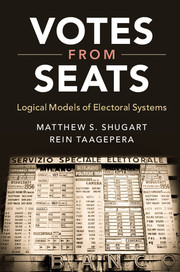Votes from Seats Logical Models of Electoral Systems
Langue : Anglais
Auteurs : Shugart Matthew S., Taagepera Rein

Four laws of party seats and votes are constructed by logic and tested, using physics-like approaches which are rare in social sciences.
Take the number of seats in a representative assembly and the number of seats in districts through which this assembly is elected. From just these two numbers, the authors of Votes from Seats show that it is possible to deduce the number of parties in the assembly and in the electorate, as well as the size of the largest party. Inside parties, the vote distributions of individual candidates likewise follow predictable patterns. Four laws of party seats and votes are constructed by logic and tested, using scientific approaches rare in social sciences. Both complex and simple electoral systems are covered, and the book offers a set of 'best practices' for electoral system design. The ability to predict so much from so little, and to apply to countries worldwide, is an advance in the systematic analysis of a core institutional feature found in any democracy, and points the way towards making social sciences more predictive.
1. Introduction: how electoral systems matter – for politics and for the scientific study thereof; Part I. Rules, Tools, and Context: 2. Components of simple electoral systems; 3. Components of complex and composite electoral systems; 4. The number of parties and proportionality – two key tools for analysis; 5. Examples of electoral systems: nationwide PR in Israel and FPTP in Trinidad and Tobago and India; 6. Two districted PR and list type: Finland, Portugal, and other cases; Part II. The Interparty Dimension of Assembly Politics: The Seat Product Model: 7. The seat product model of the effective number of assembly parties; 8. Winners plus one: how we get votes from seats; 9. Basic laws of party seats and votes - and application to deviation from proportionality; 10. All politics is national? How 'embeddedness' in a national assembly system shapes votes and seats in a district; Part III. Bringing the President In: 11. Coattails upside down: how assembly elections shape presidential elections; 12. How election timing matters in presidential democracy – and how it does not; Part IV. The Intraparty Dimension of Representation: 13. How electoral systems shape candidate vote shares; 14. Pooling or its absence: nomination and alliance behavior; Part V. What Can We Expect From Models of Electoral Systems?: 15. Extending the seat product model: upper tiers and ethnic diversity; 16. Complexities in electoral systems: do simple models work anyway? 17. Conclusion: substance and method.
Matthew S. Shugart is a Professor of Political Science at the University of California, Davis, and an Affiliated Professor of the University of Haifa, Israel. He is a world-renowned scholar of democratic institutions. He is a two-time winner of the George H. Hallet Award. He won it first for his earlier collaboration with Rein Taagepera (Seats and Votes, 1989) and again for Presidents and Assemblies (1992, with John M. Carey). He has participated as an advisor on electoral-system reform and constitutional design in several countries. Since 2005, Shugart has maintained a blog, Fruits & Votes, which serves as a forum for discussion of how electoral systems shape politics in countries around the world.
Rein Taagepera holds a Ph.D. in Physics. He is Professor Emeritus, Department of Political Science , University of California, Irvine, and Professor Emeritus, Skytte Institute , University of Tartu, Estonia. The Johan Skytte Prize (2008) and the Karl Deutsch Award by the International Political Science Association (2016) would place him among the most prominent contemporary political scientists. His most recent books are Predicting Party Sizes: The Logic of Simple Electoral Systems (2007) and Making Social Sciences More Scientific: The Need for Predictive Models (2008). In 1992, he received about a quarter of the votes in Estonia's presidential elections and was the Founding Dean of a new School of Social Sciences at the University of Tartu.
Rein Taagepera holds a Ph.D. in Physics. He is Professor Emeritus, Department of Political Science , University of California, Irvine, and Professor Emeritus, Skytte Institute , University of Tartu, Estonia. The Johan Skytte Prize (2008) and the Karl Deutsch Award by the International Political Science Association (2016) would place him among the most prominent contemporary political scientists. His most recent books are Predicting Party Sizes: The Logic of Simple Electoral Systems (2007) and Making Social Sciences More Scientific: The Need for Predictive Models (2008). In 1992, he received about a quarter of the votes in Estonia's presidential elections and was the Founding Dean of a new School of Social Sciences at the University of Tartu.
Date de parution : 10-2017
Ouvrage de 358 p.
15.8x23.6 cm
Disponible chez l'éditeur (délai d'approvisionnement : 14 jours).
Prix indicatif 112,79 €
Ajouter au panierThème de Votes from Seats :
© 2024 LAVOISIER S.A.S.



